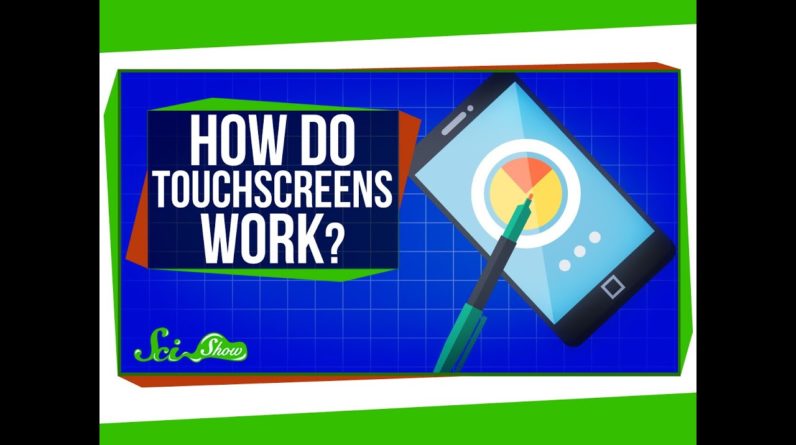
Touchscreens are everywhere. Not just in smartphones, but in supermarkets,
ATMs, and even airplane seats. And you may have noticed that not all touchscreens
are the same. The old-school touchscreens can be pretty
tough to use — sometimes it feels more like a push-really-hard-screen instead of a touchscreen. On the other hand, certain smartphones and
computer monitors are really responsive to many different touch patterns. There are lots of different technologies out
there, but they’re all trying to achieve the same goal: sending precise electrical
signals from specific locations on the screen. One of the most widely used types is the resistive
touchscreen, where you have to physically push and bend the screen to make it work.
Resistive touchscreens are made of two separate
layers: The top layer is made from a flexible and
transparent material, such as polyethylene, which is a common plastic used to make things
like soda bottles. And the bottom layer is made of something
more rigid, like a sheet of glass. To make the screen work, both of these layers
are thinly coated with some sort of metal compound that conducts electricity, like indium
tin oxide — which is commonly used because it’s transparent. These layers are also separated by tiny insulating
dots, which /don’t/ conduct electricity, called spacers. They keep the screens apart to make sure there
aren’t any false touch signals. When the screen is on, a small voltage is
applied across the screen in both the horizontal and vertical directions.
As soon as you push down on the flexible screen
with anything, like your finger or a stylus, it connects the two layers together. This changes the voltage, and a small processor
connected to the screen can calculate exactly where you pressed in X and Y coordinates. These resistive touchscreens are pretty affordable
and durable. So, they’re useful for things like credit
card readers in grocery stores, where you need to capture touch data of a messy signature
— over and over again. But they can be a little frustrating to use
if you don’t push hard enough. Plus, they normally can’t understand multiple-touches
at the same time – so they’re no good for two-finger zoom or more complex tasks. That’s why these days, most smartphones
rely on capacitive touchscreens, where your finger becomes a key part of the electronics.
There are different kinds of capacitive touchscreens,
and they can vary from device to device. But one basic design is a sheet of glass containing
a grid of hair-thin lines of a conductive metal, like indium tin oxide. The grid lines in one direction are called
the driving lines, which provide a constant electric current. And the lines in the other direction are called
the sensing lines, which detect this electric current. At every point where the sensing lines and
the driving lines cross, there will be a specific electrostatic field, which is registered as
neutral by the processor in your smartphone or computer. But that all changes when something conductive
comes along and touches it — like your finger. See, the human body has a natural capacitance,
which means our bodies can conduct electric current, and can store electric charge. So when your finger touches the screen, the
charge in the screen is drawn around that point, distorting that electrostatic field.
The electricity doesn’t actually /flow/
through your finger. Basically, the electrostatic field feels the
effects of your electric charge and redistributes itself accordingly. Even really small changes are detected by
the processor, which can then interpret the patterns you’re making – whether it’s
a tap or a slide. Because the lines of the grid are so thin,
capacitive touchscreens are super accurate, and some versions can process multiple touches
at a time. But they won’t work if you have gloves on
— because the cloth isn’t conductive, unless your gloves have those special fingertips
with metal fibers inside. Plus, something like sweat can affect how
electricity is conducted across the screen, because it’s full of salts. It’s all about the materials that can affect
the electrostatic field generated inside your screen. So next time you’re texting on a smartphone
or scrolling through internet forums on a tablet, just remember: you’re actually a
part of the electronics making it work. Thank you for watching this episode of SciShow,
which was brought to you by our patrons on Patreon.
If you want to help support our show, you
can go to patreon.com/scishow. And don’t forget to go to youtube.com/scishow
and subscribe!.




